Your Main Visa Responsibilities
Student to Student: Studying in the States provides prospective and current international student visa holders with key tips they should keep in mind in order to stay in compliance with U.S. immigration rules and ensure their time when studying at a college or university in the United States is a positive one.
The above video is from the International Student Orientation: Understanding Your Immigration Status session, which is available on YouTube and as an interactive Video on Panopto. Also, you can download the slides (pdf) for future reference.
Below are the basic requirements for maintaining F or J Student Visa Status. Please be aware that a violation of status may lead to falling out-of-status which carries some serious consequences.
- ENROLLMENT: Be enrolled full-time during standard academic semesters (fall and spring semesters). Full-time status is being enrolled in a minimum of twelve (12) credit hours per semester for undergraduate students and a minimum of nine (9) credit hours per semester for graduate students. For F-1 and J-1 students, only one 3-credit hour online class can count toward the minimum enrollment requirement. If the summer is your first semester of study in the U.S. on an F-1 or J-1 student visa, you must enroll full-time through the summer.
- ADDRESS UPDATES WITHIN 10 DAYS (SEE “YOUR ADDRESS” BELOW FOR MORE INFORMATION): All non-U.S. citizens residing in the U.S. are required to update their address within 10 days of any change of address (U.S. or Permanent Home Country Address). F and J visa holders should update their address in myBama, and ISSS will report the change to the Department of Homeland Security in SEVIS. All other visa holders should update their address both in myBama and with US Citizenship and Immigration Services by submitting the Form AR-11 online at this website: https://www.uscis.gov/addresschange.
- TRAVEL: Please contact our office before you travel outside the U.S. A valid travel signature is required on your I-20/DS-2019 for you to return to the United States.
- MONITOR DOCUMENT EXPIRATION: Know your program end date on your I-20/DS-2019. This is the date by which you should complete your studies. Please contact our office before this date if you need more time to finish your degree. We must extend your documents before they expire in order for you to be able to remain in the U.S.
- I-94 RECORD: Make sure you have a copy of your most recent I-94 Record. After arriving in the U.S., go to https://i94.cbp.dhs.gov/I94/#/home to print your electronic I-94 record. Additional information can be found at www.cbp.gov/i94.
- INSURANCE: Maintain active health insurance at all times for yourself and all F-2/J-2 dependents – University of Alabama policy mandates that all international students and scholars are required to maintain medical insurance coverage of at least:
- US $250,000 per injury/illness;
- US $50,000 coverage for repatriation of mortal remains;
- US $25,000 coverage for emergency medical evacuation; and
- A deductible that does not exceed $250 per person per policy year for in-network care and does not exceed $500 per person per policy year for out-of-network care.
- OTHER UPDATES: Notify International Student & Scholar Services within 10 days of any change to your information listed below:
- Dependents (addition of new dependents, change of name, or citizenship)
- Financial Information (when your financial information changes you must both inform ISSS, and bring to ISSS proof of finances for your studies)
You must request & receive permission from ISSS prior to acting on these Events
- Dropping below Full-time Study (below 9 credits for graduates, and 12 credits for undergraduates)
- Early completion of program (if you complete your program of study earlier than the end-date in the Program of Study section on page 1 of your I-20 or Item #3 of your DS-2019)
- Termination of studies (if you are withdrawing from UA, taking a Leave of Absence, stopping your studies, or if you have been suspended)
Your Address
All non-U.S. citizens residing in the U.S. are required to update their address within 10 days of any change of address (U.S. or Permanent Home Country Address).
F-1 and J-1 Student Visa holders should update their address in myBama, and ISSS will report the change to the Department of Homeland Security in SEVIS.
All other visa holders (not F-1 or J-1) should update their address both in myBama and with US Citizenship and Immigration Services online at this website: https://www.uscis.gov/addresschange.
The above video takes you through the steps to update your address in MyBama and is available on YouTube and as an interactive Video on Panopto.
What information do I need to update my address in myBama?
In order to update your address and phone number, you will need to find your physical address and phone number.
Understanding a U.S. Physical Address
In the greater Tuscaloosa area, there are two primary types of physical addresses: apartment addresses and residential home address. We will show you how to correctly format each type.
Apartment Address
An apartment address typically has two lines followed by the City, State, and Zip code. See the example below for a correctly completed apartment address:
1214 Paul W. Bryant Drive
Apt 123A
Tuscaloosa, AL 35401
In the example above, notice that the apartment complex name is not used in line one. Line two contains the apartment or unit number; this number can have letters and numbers. And Line 3 line indicates the city, Tuscaloosa, state AL, and 5 digit zip code.
The next apartment address example includes a building number. Some apartments will include the building as part of the address:
1214 Paul W. Bryant Drive
Building 9, Apt 123A
Tuscaloosa, AL 35401
Remember, line one is only for the physical street address. The building and apartment number are included in line two. Sometimes “bldg” is used as an abbreviation for building.
Residential House Address
A residential house address typically has one line with the number of the house and name of the street followed by the City, State, and Zip code. See the example below for a correctly completed residential address:
1234 Revere Rd
Tuscaloosa, AL 35405
In line 1, notice that the neighborhood’s name is NOT used. The street address uses only the actual street name. And the second line indicates the city, Tuscaloosa, state AL, and 5 digit zip code.
Understanding a U.S. phone number
Phone numbers in the U.S. are typically made up of 10 numerical digits. When entering a U.S. phone number in myBama, you do NOT add the + symbol on the country code “1.”
See the example below:
(205) 348-5402
This is the phone number to International Student & Scholar Services. Using the ISSS phone number as an example, we would enter “205” in the space marked for area codes. We would then enter “348-5402” as the prefix and line number respectively. We would enter either 3485402 or 348-5402 in the box marked for phone number.
Unless you have a business line, most people do not have extension numbers. If you do not have an extension, leave that box blank.
Entering Your Information in MyBama
The next step is to log into myBama and update your information.
Log into myBama and select the “Student” information menu (see green box). Then, click “Update Required Personal Information.”
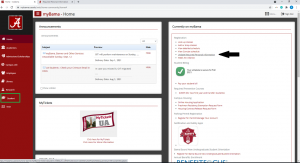
This will open a new tab on your browser. Now, select “Update Address and Phones.”

At the bottom of the page, select Local Street (non-mailing) as the address type to insert.
Remember, this is the required address type to submit to immigration. No other type will work.
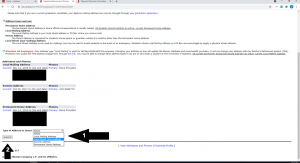
Enter your address and phone number following the instructions above.
Remember, you must click “Submit” to finalize the update.
Your Immigration Documents
Anyone on a non-immigrant visa should be able to present proof of their legal status within the United States at any time, and Alabama state law (Act 2011-535) requires that you be able to document your lawful status.
Keep documentation of your visa status up-to-date and always carry proof of status, such as a photocopy or scan/digital copy of your primary immigration documents.
Your primary immigration documents include:
- Passport. Do not allow the validity of your passport to expire. In general, your passport must be valid at least 6 months into the future. Without a valid passport, you may not be allowed to re-enter the United States after travel abroad, even if all other immigration documents are still valid. Read about what to do regarding lost or stolen passports.
- Visa Stamp. The visa stamp is entered into your passport at the U.S. Consulate or Embassy where you applied for it. The visa stamp does not govern your stay in the United States. It governs the time period during which you may apply for entry into the U.S., meaning that it must be valid for entry to the U.S. but once inside the United States, it is your I-20 or DS-2019 which governs your ability to stay. (See YOUR VISA & YOUR VISA STATUS for more details)
- I-94 Record (Arrival/Departure record). Make sure you have a copy of your most recent I-94 Record. You will now go to a website and print the electronic record of your I-94 after arrival at https://i94.cbp.dhs.gov/I94/#/home. More information can be found at: www.cbp.gov/i94. This form should indicate your arrival date, your visa status, and the length of your stay, usually marked D/S (duration of status) for both F-1 and J-1 students. It will also include an 11-digit Admission/Departure Number; this number is your I-94 number and is the identification number with DHS. (See YOUR I-94 for more details)
- I-20 or DS-2019. This is the document that proves your eligibility for F-1 or J-1 status. You must make sure that it is accurate and up-to-date at all times. (See UNDERSTANDING MY I-20 & DS-2019 for more details)
Additional Documents
In addition to the above documents, the Department of Homeland Security has also identified the following as important items to carry especially when you travel internationally (Please see our travel page for more information: Student Travel Requirements):
- Transcripts. It is highly recommended that F-1 and J-1 students who will need to renew their U.S. visa stamp during travel abroad carry copies of their University of Alabama transcripts with them to show the consular officials that you have been making satisfactory progress towards your degree. An increasing number of consulates ask for transcripts when students come to renew F-1 and J-1 visas. Transcripts may be obtained through the Student page on MyBama.
- Enrollment Verification. The enrollment verification letter is an official document which confirms your status as an active UA student and can be obtained through the Student page on MyBama.
- Financial Documentation. It is a good idea to carry financial documentation when re-entering the U.S. to prove your continuing ability to pay for studies. You must have updated financial documentation with you when applying for a new visa at a US Consulate abroad.
- Additional Proof of Identity. Carry any ID cards with you and any old passports which you may still have.
In the event of an emergency:
International Student & Scholar Services
Phone: 205-348-5402
Email: international@ua.edu
AFTER HOURS EMERGENCIES – Contact the UA Police Department:
Phone: 205-348-5454
UAPD will contact an ISSS Advisor to assist you.
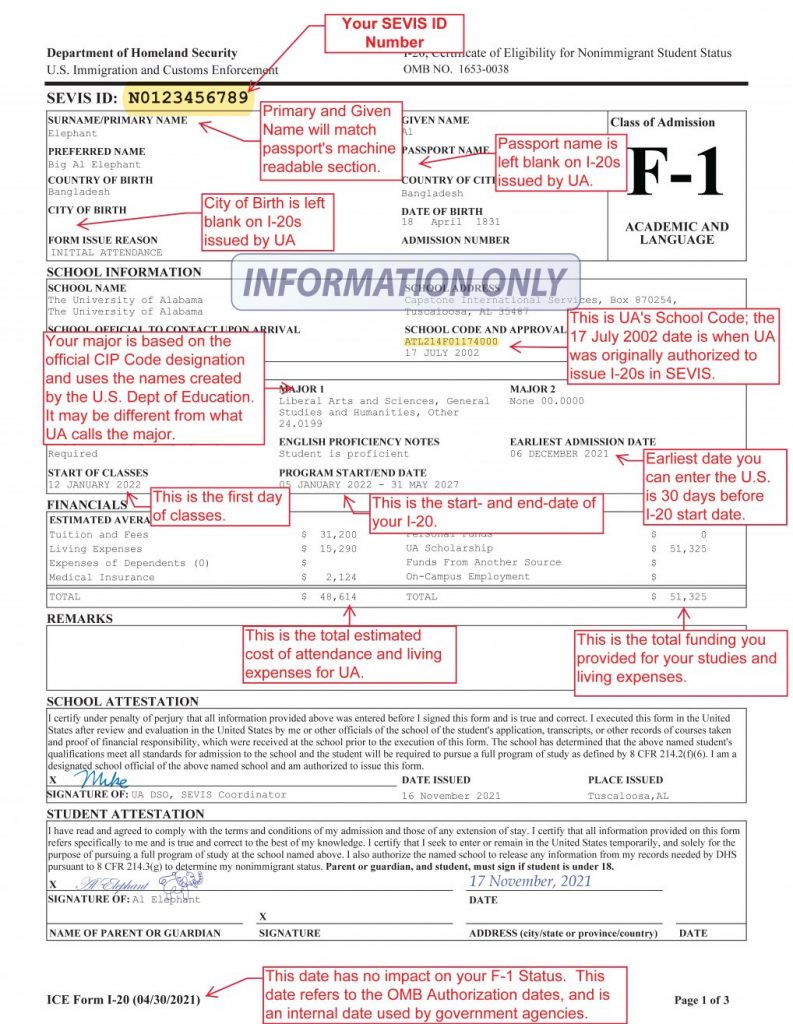
Click on the image of the I-20 to take you to our Understaning the I-20 page, where you can better understand each section, including the Personal and Biographical Information, School Information, Program of Study, Financials, and Attestations.
- SEVIS ID
- PERSONAL AND BIOGRAPHICAL INFORMATION
- SCHOOL INFORMATION
- PROGRAM OF STUDY & PROGRAM START/END DATE INFORMATION
- FINANCIALS
- SCHOOL AND STUDENT ATTESTATIONS
- EMPLOYMENT AUTHORIZATIONS/EMPLOYER INFORMATION (PAGE 2 OF I-20)
- TRAVEL ENDORSEMENT SIGNATURES (PAGE 2 OF I-20)
Note: The Form I-20 is updated with minor revisions periodically. Your actual I-20 may differ slightly from the sample included, but the main sections should be the same.
The version of the Form I-20 is noted in the bottom left corner of Page 1 of the I-20. The date listed on the Form I-20 version has no impact on a student visa status.
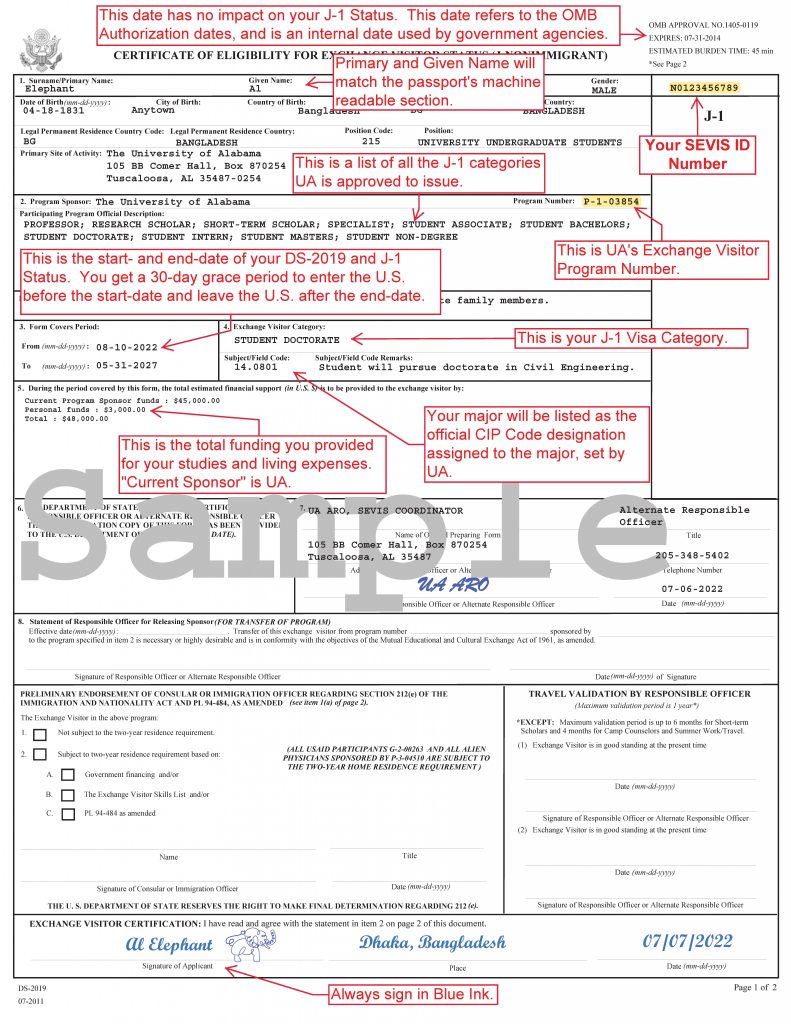
Click on the image of the DS-2019 to look at a sample J-1 DS-2019 and to better understand each section.
- SEVIS ID
- PERSONAL AND BIOGRAPHICAL INFORMATION
- PROGRAM SPONSOR INFORMATION
- PROGRAM START/END DATE INFORMATION
- EXCHANGE VISITOR CATEGORY AND STUDY FIELD CODE
- FINANCIALS
- SCHOOL ATTESTATIONS
- TRANSFER STATEMENT
- CONSULAR ENDORSEMENT
- TRAVEL VALIDATION SIGNATURES
- EV CERTIFICATION
Note: Form DS-2019 is updated with minor revisions periodically. Your actual DS-2019 may differ slightly from the sample included, but the main sections should be the same.
Your I-94
The I-94 is your Arrival and Departure Record, which confirms your “official” visa status while in the U.S.
Access your most recent I-94 online at https://i94.cbp.dhs.gov/home.
After any entry to the U.S., it is important to make sure your class of admission is correct (i.e. F-1 for student visa and J-1 for exchange visitor).
Your “Admit Until Date” should be D/S, which stands for Duration-of-Status. This means you may remain in the United States as long as you continue your course of studies, remain in your exchange program, or qualifying employment. The D/S notation, shown on your Form I-94 is the official record of your authorized length of stay in the United States. You cannot use the visa expiration date in determining or referring to your permitted length of stay in the United States.
If your I-94 record has the wrong date or does not have D/S listed, if your name is incorrect, or if you cannot access your I-94 record, you should schedule an appointment with ISSS right away.
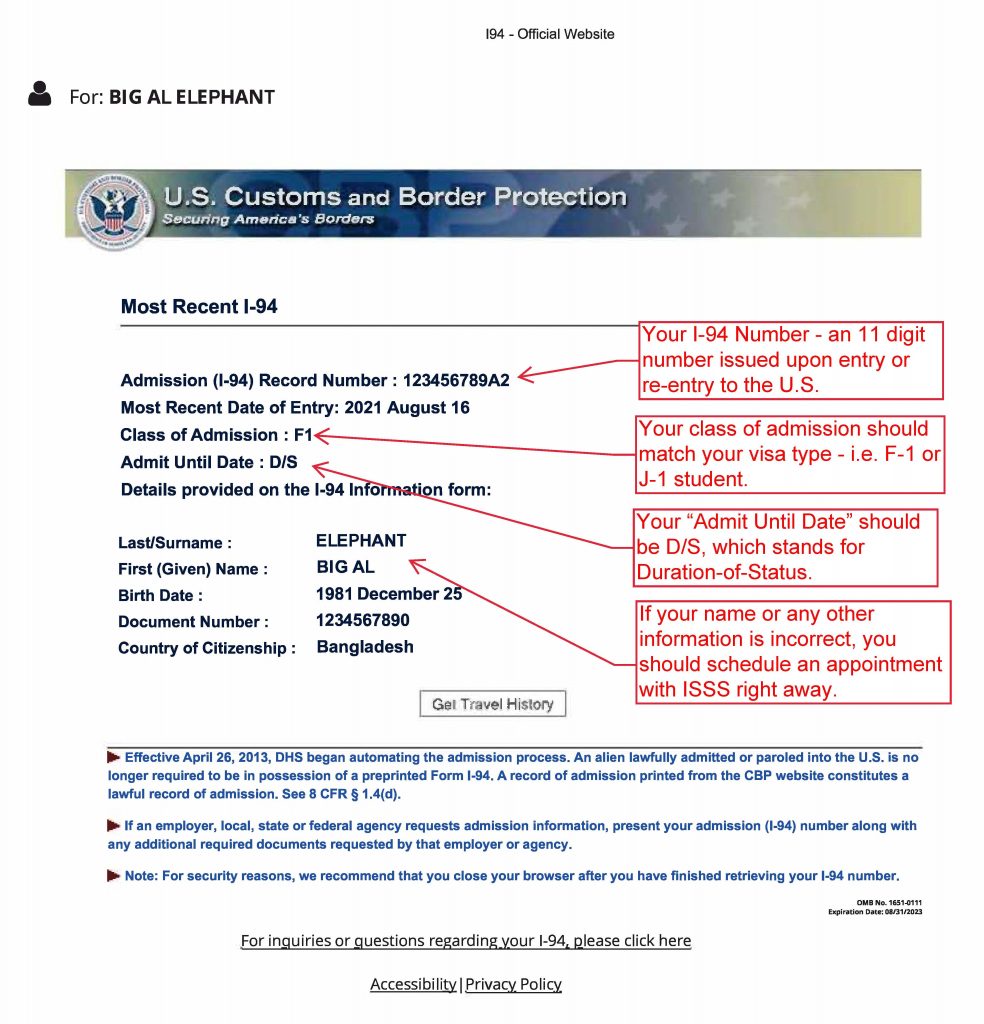
Your Visa

Sample Visa from the Department of State
Adapted from the Department of State’s “About Visas – The Basics” Page and “What the Visa Expiration Date Means” Page
A visa must be valid at the time an international student seeks admission to the United States, but the expiration date of the visa (validity period/length of time the visa can be used) has no relation to the length of time a student may be authorized by the Department of Homeland Security to remain in the United States.
Persons holding visas valid for multiple entries may make repeated trips to the United States, for travel for the same purpose, as long as the visa has not expired, and the traveler has done nothing to become ineligible to enter the United States, at port-of-entry.
If the Department of Homeland Security, Customs and Border Protection Immigration Officer at the port-of-entry admitted you into the United States for a specific period of time, s/he will note your authorized period of stay on your admission stamp or Form I-94, called an Arrival/Departure Record.
If you have D/S notated as your Admit Until Date on your Form I-94, you may remain in the United States as long as you continue your course of studies, remain in your exchange program, or qualifying practical training. The D/S notation shown on your Form I-94 is the official record of your authorized length of stay in the United States. You cannot use the visa expiration date in determining or referring to your permitted length of stay in the United States.
You will be able to remain in the United States during your authorized period of stay, even if your visa expires during the time you are in the United States.
Since your admission stamp or Form I-94 documents your authorized stay and is the official record of your permission to be in the United States, it is very important to keep a copy of your Form I-94 with you at all times.
Your Visa Status
Your Status – The difference between visa status and a visa stamp.
Everyone who enters the U.S. is given an immigration status at the U.S. Port of Entry. For most students the status granted by CBP is either an F-1 or J-1 visa status. This visa status is noted at the U.S. Port of Entry on the Form I-94.
Please be aware that immigration status is different than the visa stamp in your passport – your visa stamp is not proof of visa status or legal status. Visa stamps are used to enter the U.S., and your visa must be valid at the time you seek entry or re-entry to the United States. (See above section on Your Visa).
For those on F-1 or J-1 student visa status, your F-1 I-20 or J-1 DS-2019 control your eligibility to remain in the U.S. and your status ends based on your I-20 End-Date or DS-2019 End-Date.
For more information about Visa and Visa Status:
- Read: Department of State – About Visas- The Basics.
- Read: Department of State – What the Visa Expiration Date Means
- Read: DHS Study-in-the-States – Student Visa vs. Student Status: What is the Difference?
Benefits of Your F-1 or J-1 Student Status could include the ability to:
• Change to another immigration status from within the United States;
• Change degree level;
• Change program of study;
• Transfer to another College or University;
• Extend your status, if more time is needed to complete your degree;
• Sponsor your dependent spouse or child(ren) to join or accompany you;
• Obtain employment (under restricted conditions & only with specific approval);
• Travel outside the U.S. and reenter to continue study (with a valid VISA).
If you wish to discuss any of these benefits you should make an appointment with an Advisor at International Student & Scholar Services.
Duration (Length of Stay): You may remain legally in the U.S. as long as you are maintaining your F-1 or J-1 student visa status and engaged in a valid, full course of academic study. Those who have completed their degree may remain in the U.S. legally during authorized periods of post-graduate Optional Practical Training (OPT) or Academic Training.
When you have completed your degree or post-graduation training, you must take one of the following actions during your Grace Period (F-1 students have a 60-day Grace Period and J-1 students have a 30-day Grace Period to complete these actions):
• Change to another immigration status;
• Change degree level or program of study;
• Transfer to another University; or
• Depart the United States.
Violations – Falling Out-of-Status and Accruing Unlawful Presence: If you do not comply with all of the F-1 or J-1 student regulations, you will fall out-of-status. When you fall out-of-status, all of the benefits of your F or J visa status are cancelled, such as the ability to work on-campus or seek off-campus work authorization.
Additionally, USCIS regulations introduced on August 9, 2018 mean that you will begin to accrue unlawful presence and may face a potential bar from the U.S. The enforcement of the rule is currently under injunction as of February 6, 2020.
Despite the injunction, students who have fallen out of status may need to consult with an experienced immigration attorney regarding the accrual of unlawful presence. A list of recognized immigration attorneys can be found online at https://www.ailalawyer.com/.
Additional information about the Unlawful Presence Policy can be found on the NAFSA Website.
Resolution of your violation will depend on your specific situation. Contact International Student & Scholar Services for an appointment with an Advisor, who will consult with you about your options, including reinstatement.
